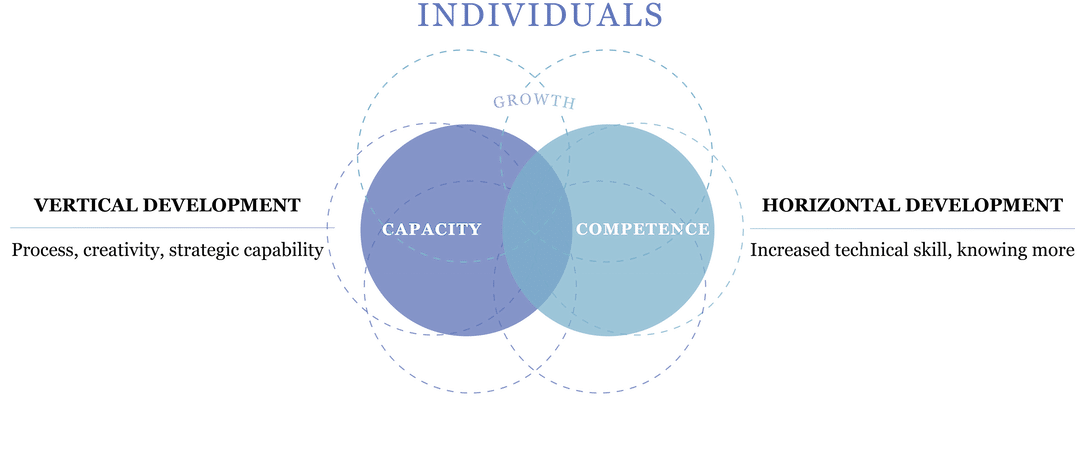In addition to offering our own programs, we are sometimes asked to partner with other providers, or internal leadership development professionals, to co-develop interventions. We are very open to this kind of collaboration.
Development can be described as occurring in two directions: horizontal and vertical. They intertwine, each informing the other, but in general terms horizontal development enables us to become more skilful and adept at things we already do. Vertical development enhances our capacity to employ our skills and express our personality. Vertical development aligns more with capacity, horizontal developmental is more about competency.
The terms “vertical & horizontal” are not without their problems as “vertical” suggests a simplistic notion of leadership capability; one where a straight pathway of development exists; where complexity of mind just increases and glosses over periods of discontinuous growth and moments of fallback (decline). It risks belittling the worth of one end of the development “scale; Opportunist, Diplomat & Expert action-logics while embellishing the value of the later action-logics (Achiever, Redefining, Transforming, Alchemical). Similarly “horizontal” separates competency; the acquisition of knowledge and skill, from the influence of our action-logic
Yet the terms are helpful if we knit them together in development. We can, in adulthood continue to learn and mature, develop new skills and a more complex and comprehensive approach to decision-making. Leaders benefit from an approach that connects vertical and horizontal approaches because adding to a knowledge base and responding in ever more complex ways,(developing through the action-logics) means they increase their capacity to respond generatively and effectively to the challenges of modern life. The “vertical” movement is one where individuals develop a deeper, broader and more dynamic worldview. The “horizontal” movement is about expanding what you know.

Competency and Capacity
So as we enhance our capacity (through action-logic change) we better express and bring into action our competencies (skills, knowledge base, talents, preferences).
Another angle is that some competencies are associated more with the earlier action-logics than the later (though continue to be accessible at the later; knowledge, expertise, time management etc).

Some frequently asked for competencies are seen at the later and not earlier action-logics (systems awareness, creating collaborative relationships and diverse networks etc). For example, when repetitive, known practices, expertise and rule-orientation trump fresh evaluations and discussions about effectiveness we are talking more about Opportunist, Diplomat and Expert leadership habits (or competencies).
When leaders focus on matters of productivity, influencing stakeholders and facilitating self-organising teams we are talking more about Achiever, Redefining and Transforming qualities (or competencies).
Our approach has consistently shown that introducing vertical development it is not for organisations that simply want a quick fix. On the other hand, if you believe in investing in the long-term leadership capacity of the people and teams in your organisation then our approach may bring rich rewards.
"*" indicates required fields
